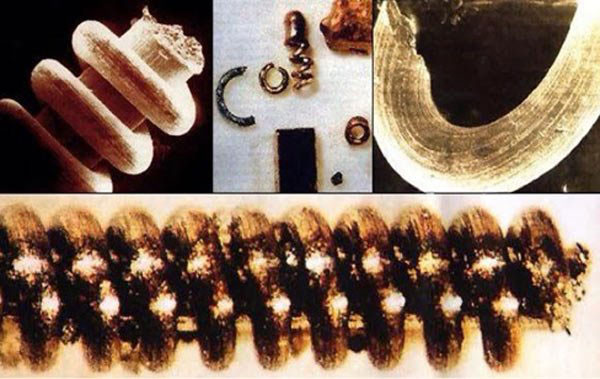Ancient nanostructures found in the mountains of Russia raise questions about humanity's level of development
Something as sophisticated and complex as nanotechnology could not have been developed without the structure of atoms and the microscope as a premise. But they've only appeared recently, so why did this microscopic and delicate structure appear about 300,000 years ago?
OOPArt is a term applied to dozens of prehistoric objects found in various parts of the world, whose existence is unusual for the context. history.
Ooparts are often described as technologically advanced objects that are far beyond the typical level of the civilization to which they are dated. Many see their appearance as proof that mainstream science is forgetting a piece of humanity's past knowledge, and delight adventurous investigators and individuals interested in alternative scientific theories.
In 1991, the appearance of extremely small, coil-shaped artifacts found near the banks of Russia's Kozhim, Narada and Balbanyu rivers sparked a debate that continues to this day. These mysterious and microscopic structures suggest that they may have been inhabited by a civilization capable of developing nanotechnology 300,000 years ago.
These fabricated coils were originally discovered during geological research related to gold mining in the Ural mountains. The shapes of these artifacts are extremely diverse, including coils, spirals, shafts, and other unidentified components.

These remarkable artifacts were found between 1991-1993 by a group of gold pans in the Narada River east of the Ural Mountains of Russia. Far from gold, what they did find were very unusual objects that were twisted in shape, the smallest measuring just 1/10,000th of an inch.
According to an analysis from the Russian Academy of Sciences in Syktyvkar, the largest pieces found were mostly made of copper, while the smallest pieces were made of tungsten and molybdenum.
The largest artifacts measure 3 cm, the smallest is only 1 / 10,000 of an inch (2.5 microns - For comparison, the average hair is about 100 microns wide). Their shape suggests that these are not natural pieces of metal, but rather man-made objects. In fact, they were found to closely resemble the walls of contemporary nanotechnology. Furthermore, it appears that the coil-shaped artifacts are completed to the Golden Ratio, giving confidence that they were intelligently created by mathematically intelligent beings.

At a glance, these objects are shaped like small shells or crustaceans (shrimp, crab) but through analysis, they have proven to be something completely different. A laboratory examined and revealed that these types of unusual objects were a form of copper zinc alloy and the rare metals tungsten (tungsten) and molybdenum. They are dated between 20,000 and 318,000 years old. The question is what are they used for and who created them?
Although some have speculated the structures are simply debris left over from rockets from the nearby Plesetsk rocket test facility, a report from the Moscow Space Institute has dated it. them and deny completely that they come from modern manufacturing.
In 1996, Dr. EW Matvejeva, from the Central Scientific Research Laboratory of Geology and Precious Metals Mining in Moscow, wrote that, despite being thousands of years old, these artifacts are all source components. technological origin is even higher than the current technological level of mankind.
How was it possible for humans to produce such small components in the distant past, and what were they used for? Some believe the coils prove humanity enjoyed sophisticated levels of technology during the Pleistocene epoch, while others assert that the finds are the work of extraterrestrials.
The artifacts were studied at four different facilities in Helsinki, St. Petersburg and Moscow. However, further study of these tiny structures seems to have ended in 1999 with the death of Dr. Johannes Fiebag, the lead researcher of the find.

An OOPArt is an artifact of historical, archaeological or paleontological interest found in an unusual setting. Such artifacts may be too advanced for technology known to have existed at the time, or may suggest the presence of humans at a time before humans are known to have existed. . Others may suggest contact between different cultures that are difficult to explain by conventional historical understanding. The term is used in unorthodox science, as well as by proponents of ancient astronaut theories and conspiracy theorists. It can describe a variety of objects, from anomalous objects studied by mainstream science to archeology or objects believed to be hoaxes.
- Found mountains in the North Pole
- Ancient people also love the game of
- Successfully developed nanostructures are harder than diamonds
- Found the world missing the bottom of the Pacific Ocean
- Ancient instruments still play well after 1,700 years
- The Antarctic glacier melted easily to raise the sea level by 3.4 meters
- The secret of the magical, ancient temple of Chavin in Peru
- Control the level of development of tissues and blood vessels instead
- Discovered a tomb full of treasures in southern Russia
- Meteor makes the night sky as bright as day in Russia
- People on high mountains are unlikely to get Covid-19 virus
- The 17 most brainwarming questions of technology corporations
 The most famous scientific failures in history
The most famous scientific failures in history Mysterious genius mechanic and the machine froze time
Mysterious genius mechanic and the machine froze time The son carries the 'bad gene' of genius Albert Einstein
The son carries the 'bad gene' of genius Albert Einstein Isaac Newton
Isaac Newton